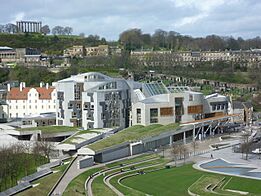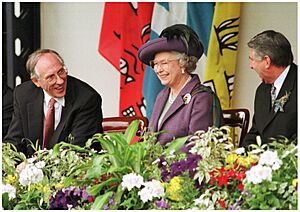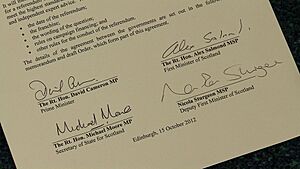Scottish devolution facts for kids

Devolution is when a central government, like the UK Parliament in London, gives some of its powers to a local parliament. In Scotland, this means the Scottish Parliament gets to make decisions on many things. Some people wanted a Scottish Parliament, while others wanted Scotland to be completely independent.
Scots first voted on devolution in 1979. Most people voted 'Yes', but not enough people voted for the plan to go ahead. In 1997, another vote happened. This time, a huge number of people voted 'Yes'. This led to the Scotland Act 1998 being passed. The Scottish Parliament was then created in 1999.
In 2014, Scottish voters had a chance to vote for full independence. UK political parties promised to give more powers to Scotland if it stayed in the UK. The 'No' vote won, meaning Scotland remained part of the UK. This promise led to the Smith Commission and later the Scotland Act 2016.
History of Devolution
From 1707 to 1999
The Parliament of Scotland stopped meeting on March 25, 1707. This was after it agreed to the Union with England Act. A new country, the Kingdom of Great Britain, began on May 1, 1707. It had one parliament in London, combining the parliaments of England and Scotland.
For a long time, Scotland was mainly managed by a UK government minister. In 1885, the Scottish Office was created. A new job, the Secretary for Scotland, was also made. This person later became the Secretary of State for Scotland in 1926. They were a full member of the UK government's cabinet.
In 1913, there was a bill called the Government of Scotland Bill. It aimed to give Scotland more self-rule. The House of Commons voted for it, but it stopped because World War I started.
The Scottish Covenant (1940s and 1950s)
The Scottish Covenant Association was a group that wanted a Scottish Parliament. They were not linked to one political party. They created the Scottish Covenant, a petition that got two million signatures.
Members of this group also famously moved the Stone of Destiny from Westminster Abbey in 1950. This brought a lot of attention to the idea of Scottish self-rule.
The 1979 Devolution Vote
In 1979, Scotland held a vote on whether to create a Scottish Assembly. For the plan to pass, 40% of all people who could vote had to say 'Yes'. Most people who voted said 'Yes', but it was not enough to reach the 40% rule. So, the plan did not happen.
The 1997 Devolution Vote
In 1997, Scotland had another vote on devolution. This time, people were asked two questions. First, did they want a Scottish Parliament? Second, should this parliament have the power to change taxes? Most people voted 'Yes' to both.
Because of this clear result, the UK Parliament passed the Scotland Act 1998. This law created the Scottish Parliament and the Scottish Executive.
The Scotland Act 1998
The Labour government introduced this Act in 1998. It set up the Scottish Parliament. It explained how Members of the Scottish Parliament (MSPs) would be chosen. It also said how the Parliament would make new laws, called Acts of the Scottish Parliament.
The Act gave the Scottish Parliament power over many areas. But it kept some important matters, like defence and foreign policy, for the UK Parliament. These are called "reserved matters." The UK Parliament can still make laws for Scotland if it needs to.
Scottish Parliament Opens (1999)

The Scottish Parliament first met on May 12, 1999. A member named Winnie Ewing said a famous line: "the Scottish Parliament, adjourned on 25th day of March in the year 1707, is hereby reconvened."
The new Scottish Parliament Building officially opened in 2004. Before that, the Parliament met in the General Assembly Hall of the Church of Scotland. The new building was designed to connect with Scotland's landscape and culture. It won many awards for its design.
In 2005, more powers were given to the Scottish Parliament. This included control over Scotland's railway system. This was a big step for devolution.
In 2007, the Scottish Executive changed its name to the Scottish Government. This happened after the Scottish National Party took charge.
More powers were transferred in 2008. These included decisions about planning and protecting nature in the sea near Scotland. This affects things like offshore oil and wind farms.
Independence Referendum (2014)
In 2009, the Scottish National Party (SNP) wanted to hold a vote on Scottish independence. But they did not have enough support in the Scottish Parliament at the time.
After the 2011 election, the SNP had a majority. They again pushed for an independence vote. The Edinburgh Agreement (2012) was signed. This allowed the Scottish Parliament to hold the vote. The vote was a clear choice: independence or staying in the UK.
Just before the vote in 2014, UK party leaders made "The Vow." They promised to give Scotland "extensive new powers" if it stayed in the UK. The vote happened on September 18, 2014. Independence was rejected, with 55% voting 'No' and 45% voting 'Yes'.
The Smith Commission
The day after the independence vote, the Smith Commission was set up. Its job was to talk to all political parties. They needed to suggest how to give more powers to the Scottish Parliament.
In November 2014, the commission made its suggestions. These included giving the Scottish Parliament full power to set income tax rates. It also suggested more borrowing powers and other rights.
The Scotland Act 2016
Based on the Smith Commission's ideas, the Scotland Act 2016 became law in March 2016. This Act changed the Scotland Act 1998. It gave even more powers to Scotland, such as:
- The ability to change parts of the Scotland Act 1998 about how the Scottish Parliament works.
- Control over things like onshore oil and gas, train services, and consumer advice.
- Management of the Crown Estate in Scotland.
- Control over some taxes, like Air Passenger Duty.
- Full control over Scottish income tax rates.
The Act also said that the Scottish Parliament and Scottish Government are a permanent part of the UK's system. They can only be removed if there is a vote.
Ideas for More Devolution
SNP Proposals
The SNP has often asked for more powers for Scotland. In 2015, they wanted control over company tax, National Insurance, and welfare. They also wanted full financial control for Scotland. They also suggested that broadcasting should be decided in Scotland.
In 2019, the SNP asked for powers over drug laws, immigration, and employment laws. They also wanted more control over gambling rules and consumer protection. In 2023, they called for powers over energy and inheritance tax.
Labour Proposals
The UK Labour Party leader, Keir Starmer, wants to change how the UK works. He asked Gordon Brown, a former Prime Minister, to lead a group looking at this. Gordon Brown has suggested a "federal" system. This would give more power to the Scottish Parliament.
Labour's ideas include:
- Allowing the Scottish Parliament to make agreements with other countries on devolved matters.
- Giving Scotland control over job centre services.
- Making the Sewel convention a legally binding rule. This rule says the UK Parliament usually needs the Scottish Parliament's agreement for laws affecting Scotland.
Changes by the UK Parliament
After Brexit, the UK government passed the United Kingdom Internal Market Act 2020. This law aimed to keep trade smooth across the UK. The SNP in Scotland did not like this Act. They said it went against devolution. However, Scottish Conservatives and some businesses supported it. This Act also allows UK ministers to spend money on devolved areas without the Scottish Parliament's approval.
In 2022, the Scottish Parliament passed the Gender Recognition Reform (Scotland) Bill. But in January 2023, the UK government used a special power to stop this bill from becoming law.
See also
- Scottish Social Attitudes Survey
- Scottish Constitutional Convention
- Constitutional status of Orkney, Shetland and the Western Isles
- Devolution in the United Kingdom
- Welsh devolution


